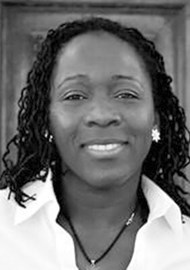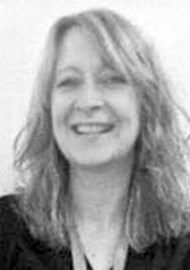Marette, Kate and Justine from the Birmingham Paediatric Centre give a detailed insight into how their team works together to assess children and young people for potential cochlear implantation.
Cochlear implants and the specialist MDT
The multidisciplinary team in cochlear implant (CI) assessment for children and young people, sees professionals bring their knowledge and skills to confirm, where possible, the nature and extent of the hearing loss, and to determine if a CI is an appropriate management option to support a child’s personal, social, health and education needs. Such a decision depends on a number of factors and so a multidisciplinary approach is typically adopted.
The British Cochlear Implant Group (BCIG) suggests a cochlear implant service should be delivered by an MDT of specialist professionals:
“The team will have expertise in otology (surgical and nursing), clinical science (audiological scientists and/or clinical physicists), clinical physiology (audiologists and/or hearing therapists) and rehabilitation (speech and language therapists and/or teachers of the deaf and/or auditory verbal therapists). Where clinical psychology is not available as part of the core team, it is recommended that the team has access to clinical psychology services with experience in working with severe/profound deafness. Access should also be available to other appropriate health professionals (e.g. audiovestibular physicians, paediatricians and geriatricians). The team must have the knowledge and skills to assess and work with children and adults with a range of complex needs, additional to their deafness.”
The professional skill mix of a CI service MDT can vary slightly across teams. The key point, we would suggest, is that there is good liaison between the core clinical team, other hospital departments, local professionals and the family. This is crucial to achieving a positive outcome for the deaf child or young person.
“The specialist professionals in CI services routinely review, collate, share and disseminate approaches used in their practice and the subsequent outcomes”
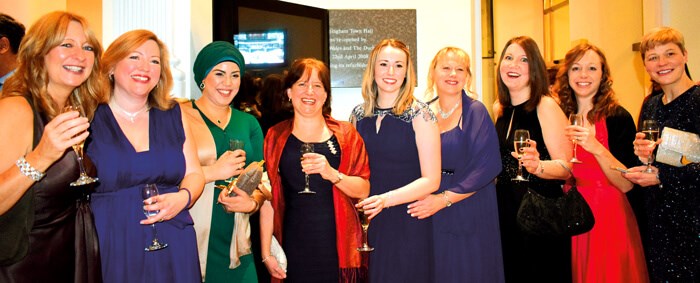
BCIG 2017 – The specialist MDT that plays together stays together.
The specialist MDT informs standards of clinical care
The field of CIs has evolved rapidly in the last 30 years with CIs now the standard of care in the UK for children with severe to profound hearing loss, particularly where the desired outcome is spoken language. Technological advances in hardware and corresponding developments in surgical techniques, along with new sound processing strategies and innovative rehabilitation, have combined to maximise functional outcomes with CIs. The specialist professionals in CI services routinely review, collate, share and disseminate approaches used in their practice and the subsequent outcomes.
Informed by the evidence base of such outcomes, the inclusion criteria for children who might benefit from a CI has been developed and refined to include the expansion of audiometric CI candidacy criteria in many parts of the world for cohorts with: (1) more residual hearing; (2) partial hearing which may benefit from a combination of electric and acoustic auditory stimulation; and (3) asymmetric hearing levels.
ChIP: a paediatric CI assessment tool for MDTs
With so many factors to consider, it is helpful to have a way of bringing together the multiple strands of the CI assessment process for review and discussion. The Children’s Implant Profile or ChIP is a tool regularly used by the MDT to support the decision-making process. Developed in the 1990s, the original ChIP considers 11 areas including medical, radiological, audiological, developmental, educational, expectations of CI, and availability of family and professional support. Professionals within the MDT rate these factors on a three-point scale from (1) no concern, (2) some concern, to (3) concern so great as to preclude CI. Using the same three-point scale format, many paediatric CI teams routinely use modified, updated or sub-group versions; for example, a sequential bilateral ChIP developed following approval in the UK for bilateral CIs for children.
Within our team, the latest version of the ChIP has been reworded to provide more detail regarding the factors under consideration. For example, our ChIP specifically highlights potential cardiac issues and neurological impairments facilitating optimal care pathways. Family structure and support, and understanding and engagement with the CI assessment process have been given far greater prominence as a result of a growing number of our families experiencing extreme social needs. This is to ensure appropriate support is in place for the family before CI surgery.
Despite its age, the ChIP remains an invaluable tool for supporting MDT working. Additionally, the ChIP can be used as a counselling tool to talk with families about potential outcomes, e.g. based on long duration of deafness, or identifying individuals who may need more support due to additional educational needs. Use of a ChIP not only supports consistency of decision making within CI service MDTs but also between CI services.
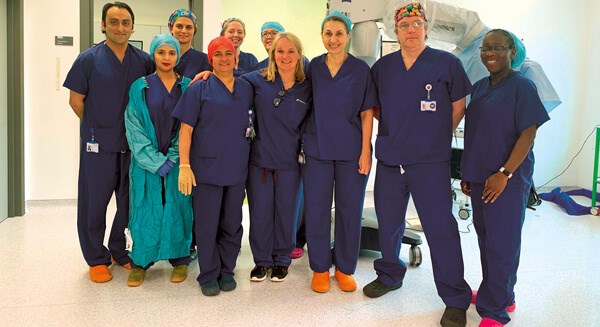
CI surgical team at Birmingham Children’s Hospital.
The specialist MDT for complex cases
Universal neonatal hearing screening, coupled with the most recent NICE guidance on cochlear implants, means CI assessment for a well baby born with severe/profound hearing loss is typically straightforward for an experienced paediatric CI team. The experience of paediatric CI teams has progressed alongside developments in the field of neonatology where babies born as early as 24 weeks gestation are successfully treated. Whilst a few may survive without major health complications, many of the surviving children are highly medically complex, with a subset having permanent hearing impairment. As such, children with significant physical delay, significant cognitive impairment, serious medical comorbidities, or any combination of the above are now often referred for CI assessment.
The desired outcome for these children may be access to speech and environmental sounds to improve quality of life, rather than achieving functional spoken language. This patient group represents a growing number of complex cases where the specialist skills of an experienced MDT, together with the extended team, need to be exercised to achieve a successful outcome for the child.
Another group who can present a challenge are those where there is a mismatch between the child’s audiometric hearing thresholds and their functional ability. This includes, for example, children with auditory neuropathy spectrum disorder (ANSD) or X-linked deafness, who may have hearing thresholds which do not meet the audiometric criteria for CI, but whose functional hearing performance is consistent with severe/profound hearing loss and whose speech, language and listening skills are significantly below expected levels. For X-linked deafness, radiologist and ENT input can diagnose the condition which results in poorer than expected functional ability. For children with ANSD, a hearing aid trial coupled with appropriate intervention from a communication and language specialist and careful monitoring by the specialist MDT, local services and the family, can verify reduced potential to benefit from hearing aids. Based on their audiograms alone these children would not be offered a CI, yet their outcomes with CI surpass their ability to function with conventional amplification.
“Despite its age, the ChIP remains an invaluable tool for supporting MDT working”
A more specific example of effectiveness of the MDT for complex cases includes that of a 12-year-old boy with a history of progressive hearing loss, longstanding ear infections, and extreme anxiety over any radiological or surgical procedure. Having refused two surgical procedures before referral to us, there was limited hope of obtaining his consent and cooperation for surgery. Clinical psychology and the play therapy team supported him over a number of months exploring past experiences, preparing him for procedures, helping create extremely detailed treatment plans, and teaching coping strategies for routine CI medical clinic appointments. This extended process resulted in a successful CI surgery and a hugely positive outcome for this young man.
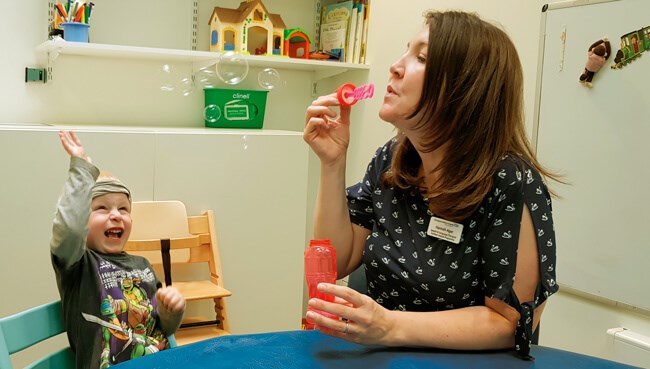
A young child with CIs develops listening and talking skills through play in his therapy session.
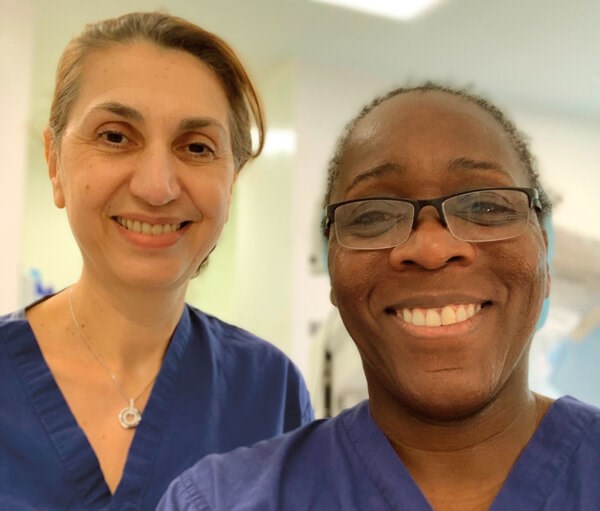
CI Surgeon, Konstance Tzifa, and Clinical Scientist, Marette Ambler.
The power of the specialist MDT
An MDT is an effective and efficient way of acquiring an holistic view of the child and the family. In the current healthcare climate, more than ever, the power of the MDT is released through an interdisciplinary model of working; where there is regular and effective communication between disciplines. Talk to your colleagues. Talk to your local support teams. Involve the family. An in-depth understanding of the assessment process beyond the specialist expertise of any one person allows team members to provide families with a sensible overview and appropriate signposting to other resources. The interdisciplinary model supercharges the MDT, making it more than the sum of its clinical parts. It is important to respect professional boundaries and understand your own limitations. However, a seamless, efficient, timely and family friendly service can be the result.
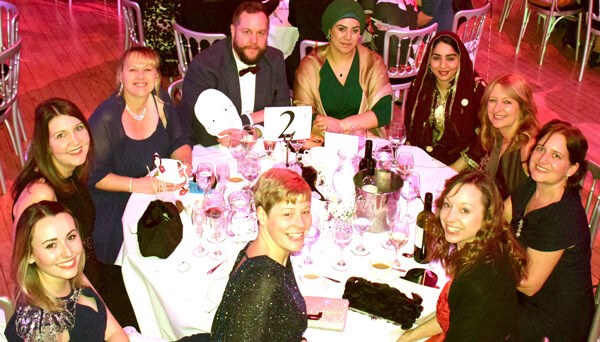
Midlands Hearing Implant Programme at BCIG 2017.
FURTHER READING
British Cochlear Implant Group. Quality Standards Cochlear Implant Services for Children and Adults
www.bcig.org.uk/wp-content/
uploads/2018/05/QS-update
-2018-PDF-final.pdf
Last accessed March 2020.
NICE Guidance on Cochlear implants for children and adults with severe to profound deafness.
www.nice.org.uk/guidance/TA566
Last accessed March 2020.
Hellman SA, Chute PM, Kretschmer RE, et al. The Development of a Children’s Implant Profile. American Annals of the Deaf 1991;136(2):77-81.
NHS England. Cochlear Implantation and patients with ANSD. Specialised Services Circular.
www.bcig.org.uk/wp-content/
uploads/2010/10/SSC1442_ANSD.pdf
Last accessed March 2020.
Declaration of Competing Interests: None declared.


